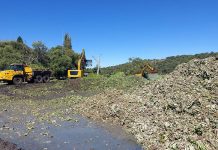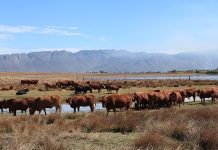According to soil expert Neal Kinsey, a sufficient supply of phosphorous at planting during the early stages and germination is essential for most grain crops to ensure rapid seedling growth. A shortage of phosphorous in wheat during seed set could cause pollination problems and small wheat ears that curve to one side. A sustainable supply is needed for maize production, as phosphorous is associated with good kernel set, making the kernels fill out right to the top of the cob.
However, since boron is also associated with good kernel set, farmers should determine which of these nutrients is deficient before applying one blindly to address kernel set problems. Insufficient phosphorous in pasture also increases bloat in cattle. Neal recalls a research trial on a new clover variety. “Half the farmers loved it, while the other half said it caused terrible bloating in their cattle. A soil analysis revealed that all the farmers whose animals suffered bloating had a phosphorous deficiency in their soil.” Neal proposes soil should contain at least 300kg/ha phosphorous, but preferably between 500kg/ha to 800kg/ha for optimal production depending on specific crop needs.
Phosphorous is measured in P2O5 as this is the form in which it’s usually bought. To calculate the amount of elemental phosphorous in this compound, divide the mass of by 2,3. P hosphorous is conveniently divided into soil feeding and plant feeding types. Neal feels it’s better to source manure or compost with a high phosphorous level as a soil feeder than buy a commercial soil-feeding phosphorous. “You get a far better biological effect and value for money,” he says. Farmers must remember the rule of excess and minimum – if you apply too much manure, the phosphorous or excess nutrients will leach into the soil, hurting the soil nutrient balance.
Phosphorous sources Pig manure is particularly rich in phosphorous, and usually contains more phosphorous than potassium, except in a dry year, when the soil’s low phosphate content carries over into pig feed. In contrast, cow manure usually has a high potassium and low phosphorous content. Hard and soft rock phosphates are also natural soil-feeding phosphorous sources, but may be harder to obtain and release more slowly than plant-feeding foliar feeds. Hard rock phosphates also release very slowly in a soil with a pH (water) exceeding 6,5, and need a healthy soil life to make them soluble. Soft rock phosphate is a good source if you need calcium and phosphorous.
Neal adds that most of his clients using rock phosphate don’t mind the slow release period, because they don’t have to reapply it for five to 20 years. Only legumes can use the phosphorous during the first year, as only in the second year will there be enough of it for wheat. Neal points out that farmers can work legumes back into the soil to build the phosphate level for the next crop. The granular size of the phosphate source also affects the rate of release.
To test whether the source is fine enough, John Fair, considered the father of biological farming in SA, advises in his book John Fair’s Guide to Profitable Pastures that around 60% must pass through a 100 mesh screen. Diammonium phosphates (DAP) and mono-ammonium phosphates (MAP) are the other commercial soil builders. Fair prefers DAP for pasture, because it contains more nitrogen. MAP is a better choice on soils with a pH (water) above 7,5.
Timing applications In general, soil-feeding phosphate can be applied at any time and the phosphorous will be available to the plant as needed. Plant-feeding phosphate, such as super phosphate or triple super phosphate, is usually cheaper but doesn’t build the soil and must be applied annually. Neal explains that plant-feeding phosphates will revert back to tricalcium phosphate, which only legumes can easily absorb, within eight weeks after application under optimal conditions. “Plant-feeding phosphates are usually highly acidic with a pH of 3 or less,” he explains. “In a soil with a pH (water) above 5,5 phosphorous will latch onto calcium to form tricalcium phosphate.
Under adverse conditions, this reaction can take as little as four weeks. The phosphorous is, in effect, lost to the plant.” Research confirms plants usually only take up 20% of the phosphorous in a plant-feeding phosphate under favourable conditions. The remaining 80% is usually represented by phosphorous already available in the soil. Under adverse conditions, plants take up 90% from the soil, and only 10% from the plant-feed. Contact SA Biofarm at (012) 333 4222 or visit www.sabiofarm.co.za. |fw
Factors affecting phosphorous availability
Various factors influence phosphorous availability, starting with a direct link between the level of available phosphorous and other nutrients. “Soil high in sulphur needs more phosphorous,” says Neal. “If phosphorous availability is borderline, high zinc levels can impede uptake so more phosphorous is needed for production. Highly acidic phosphorous sources react with calcium, rendering the phosphorous unavailable to the plant.” Magnesium is vital to phosphorous metabolism. Without it, (see Farmers Weekly 8 August), phosphorous uptake will be impeded. Neal advises farmers to use plant-feeding phosphate until the problem is rectified. Plants can’t absorb phosphorous under cold conditions.
Apply it in warm weather for optimal uptake. Other factors include soil aeration, compaction and moisture. Microorganisms, such as mycorrhiza, convert phosphorous to plant-available form. They need sufficient air and moisture, but excessive moisture destroys them. Don’t apply chemicals toxic to them. Anhydrous ammonium can deplete mycorrhiza for up to eight weeks. Compaction influences aeration and makes it difficult for plant roots to penetrate the soil and get in direct contact with phosphorous. Place the phosphorous as close to roots as possible. Unlike other anions, phosphorous tends to stay where it’s placed, so application time and method are crucial to phosphorous availability.








